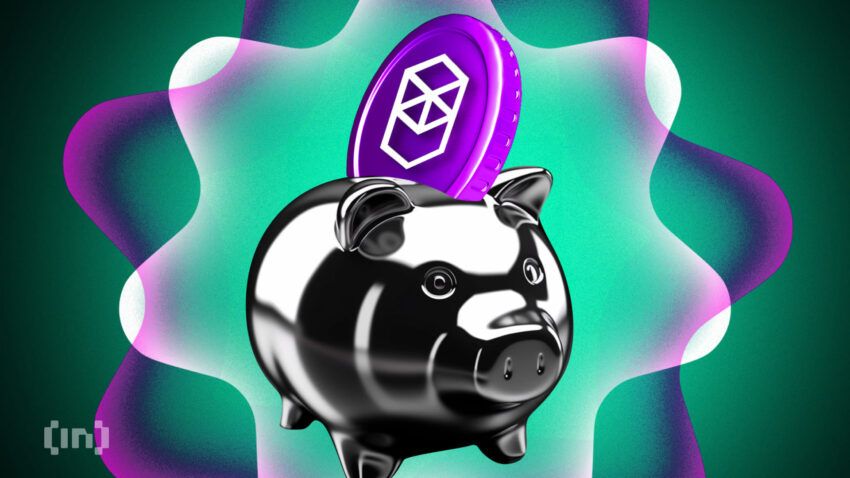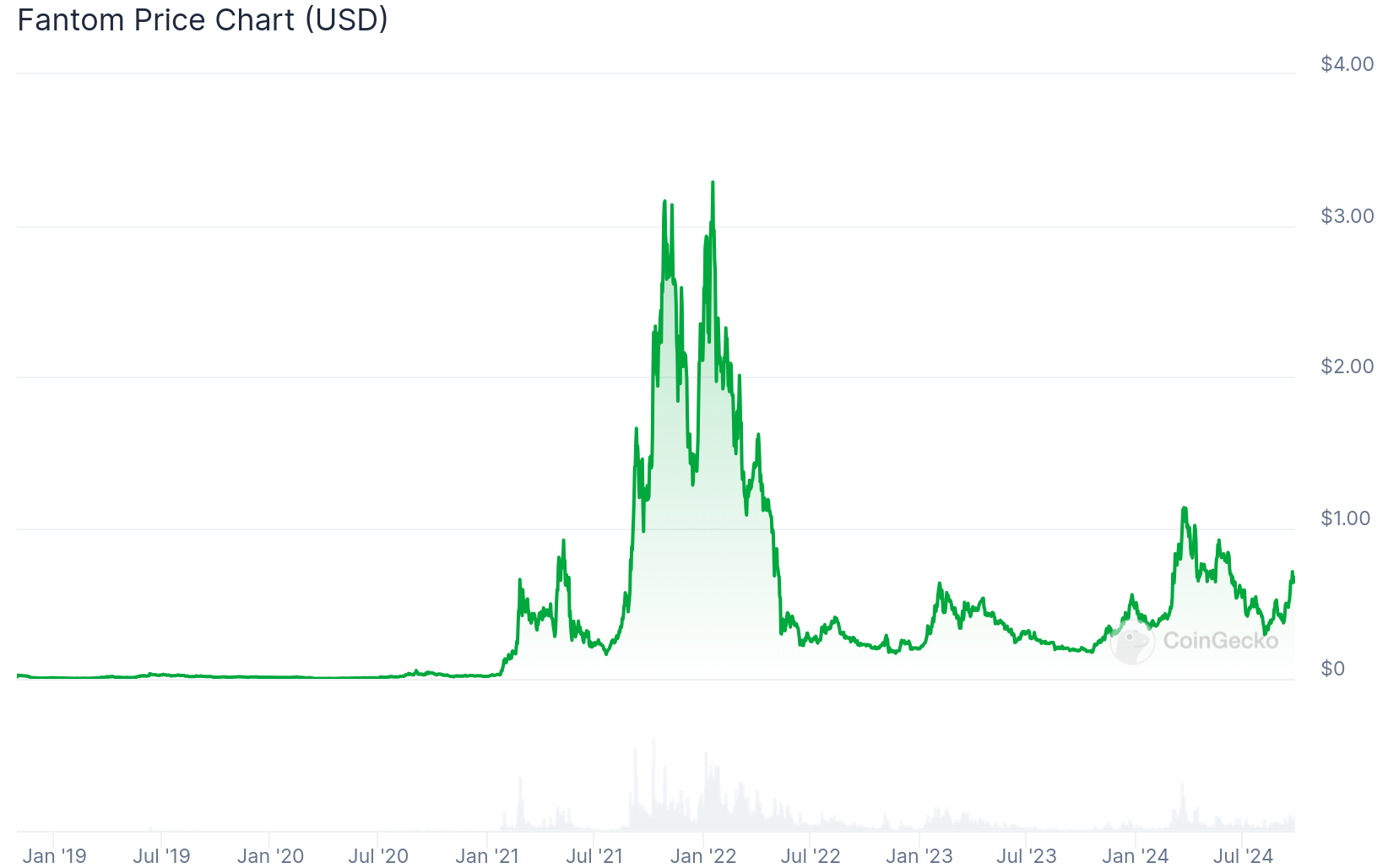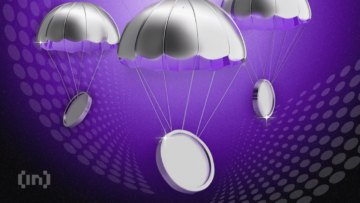In response to the glaring limitations of the Ethereum network, a lot of projects have been erupting to fill these problems. Among these crypto projects is Fantom, which aims to solve the “blockchain trilemma,” whereby scalability, security, and decentralization are difficult to achieve at once. FTM — the network’s token is used for governance, staking, and paying fees for deploying apps in the blockchain. Here’s what you need to know.
KEY TAKEAWAYS
➤ Fantom is a layer-1 blockchain that uses a Directed Acyclic Graph (DAG) and the Lachesis protocol to ensure high scalability.
➤ Fantom’s blockchain network, Fantom Opera, is EVM-compatible which allows developers to deploy Ethereum-based smart contracts.
➤ The FTM token powers the Fantom network, is used for governance, staking, and transaction fees, and is transitioning into SONIC.
➤ Fantom’s approach of creating independent blockchains for each deployed smart contract also improves its scalability.
What is Fantom?

Fantom is a layer-1 distributed ledger that offers seamless deployment of smart contracts on its network. The platform uses an advanced DAG — directed acyclic graph — which involves the seamless interaction of computer nodes in a network to ensure fast and secure transactions.
Fantom uses a distinct proof-of-stake (PoS) model. It uses an independent layer called the “Lachesis Protocol” to achieve consensus. The goal of this protocol is to be integrated into the EVM-compatible smart contract chain called the Fantom Opera chain.
Essentially, it allows several projects to be built on the Fantom Opera chain and enjoy Fantom’s basic functionalities. This includes swift transactions and minimal transaction costs for all users while maintaining effective security.
Lachesis works like the regular PoS platform, but this technology is faster and much more cost-effective. It combines different time periods and executes them on a single vote. This method facilitates the high throughput by processing 4500 transactions per second, including basic transactions and smart contracts.
Fantom is aiming to be a reliable alternative to Bitcoin, whose transaction confirmations can take up to an hour, and Ethereum, which can take up to 10 minutes. Fantom network only takes about one or two seconds to process transactions while aiming for 300,000 transactions per second.
The evolution of Fantom (FTM)
After putting much research and planning into building an ecosystem for months, Fantom was officially launched in January 2018. This was done by a team called Fantom Foundation.
The Fantom Foundation seeks to develop the ecosystem for a more decentralized, transparent, and adept future. The group comprises engineers, scientists, researchers, designers, and entrepreneurs who share the same goal.
In 2024, Fantom (the research company) and the Fantom Foundation rebranded to Sonic and Sonic Labs. This was followed by an announcement to transition the FTM token to SONIC and the creation of a new blockchain, Sonic Chain, which will run alongside Fantom Opera.
According to its whitepaper, the Lachesis consensus protocol (or Lachesis protocol) and a directed acyclic graph (DAG) put Fantom to work. These two help the network maintain asynchronous Byzantine fault tolerance (aBFT).
In December 2019, the project built its first layer, Opera Chain, which involves compatibility with the Ethereum Virtual Machine smart contract. This makes FTM available as an ERC-20 token standard.
Opera chain is a PoS layer that relies on Lachesis to confirm transactions and generate new blocks within the network. It supports Curve, CREAM, and other popular decentralized finance (DeFi) applications.
In the second quarter of 2019, Fantom built quite a special place in the hearts of many when it announced integration into Binance Chain. FTM is available on Binance Chain tokens as BEP-2. Lastly, in September 2021, Andre Conje, a founding member, launched NFT marketplace on Fantom network.
How does Fantom (FTM) work?

As explained earlier, basically, Fantom has two technologies backing it, which are DAG and Lachesis. DAG allows swift validation of transactions while Lachesis provides security to the multiple chains deployed within the ecosystem. Lachesis does a lot of work in the ecosystem, and it has been broken down for easier explanation.
Asynchronous Byzantine Fault Tolerant (aBFT)
Decentralization gives room for complete freedom, which allows people to disobey the protocol rules. How can you ensure a stabilized network and ensure all the nodes reach a fair consensus (agreement)? This is what Byzantine Fault Tolerance solves.
Byzantine Fault Tolerance ensures a trustless and transparent network, even with potential malicious acts. The network nodes agree on the timing and process of transactions as well as block production.
However, with Asynchronous Byzantine Fault Tolerance (aBFT), users are free to process orders at different times. It is an improved version of Byzantine Fault Tolerance (BFT) that enables a decentralized, trustless network.
Byzantine Fault Tolerance enables the network to come to a fair consensus, even if up to 1/3 of nodes decide to hinder that agreement, perhaps by delaying transactions. Asynchronous Byzantine Fault Tolerance (aBFT) improves BFT by removing the time limit on delayed messages and allowing them to be lost completely.
Lachesis powers “Opera,” Fantom’s mainnet blockchain platform
Unlike the typical PoS models, where validators have the final say on the confirmation of transactions, the opera mainnet is absolutely leaderless, thereby enabling users to play a unique role in producing blocks. Generally, taking off leaders massively boosts network security.
On the Opera chain, any network user can become a validator by running their node. Validating nodes helps with the security of the network. Also, FTM holders can become a delegator by holding as low as one FTM.
Fantom DeFi
Fantom has solid support for the Defi ecosystem. On the network, you can access its Defi offerings and trade directly from your wallet. Below is a definition of the common terms used within the platform.
- fWallet: A fantom wallet that allows you to deposit and store FTM
- fUSD: a Fantom-based stablecoin, you can trade, lend, and borrow with this on fLend. You can also mint fUSD with fMint.
- fLend: a liquidity pool that allows users to lend or borrow
- fSwap: a decentralized asset trading platform that allows users to swap between different tokens
Fantom vs. competitors

Fantom appears to stand out alongside its other competitors. Ethereum, Solana, and Cardano are big competitors to Fantom. Distinctively, these projects offer improved scalability and effective transaction fees to blockchain networks.
Some crypto professionals have touted Fantom to be the next Ethereum or Solana. And the main difference between Fantom and these other projects is that Fantom creates an entirely new blockchain for each deployed smart contract, while others don’t.
This massively boosts interoperability, thereby reducing the workload in the network. This also fosters scalability as these blockchains act differently within the network. They are, however, connected using the same consensus algorithm.
Let’s compare these networks based on transaction speed and time.
- Transaction per second: Most times, the values indicated by the blockchain’s website are not always realistic tps values. For example, Solana claims about 50,000 tps but only processes up to about 300 tps. Cardano processes about 260 tps, while Polkadot records around 170 tps. The practical value for Fantom is around 11 tps.
- Block time: Fantom has a practical block time of one sec, Polkadot has six seconds while it takes 20 secs for Cardano to generate new blocks. Solana is undoubtedly the fastest here, with 0.6 seconds.
| Blockchain | Mechanism | VM | TPS (theoretically) | Type |
|---|---|---|---|---|
| Fantom | PoS | EVM | 4,500 | Sidechain |
| Ethereum | PoS | EVM | 15-30 | Modular |
| Cardano | PoS | No | 250 | Monolithic |
| Solana | PoS | SVM | 50,000 | Monolithic |
Roadmap and development history
In line with the whitepaper, the platform features five different milestones, which include the Intermezzo stage, Seria stage, Buffa stage, Opera Stage, and Grand Opera stage. The below diagram should give a broader overview of the roadmap milestones.
A quick summary of the development history includes the release of the testnet in late 2019. This testnet was mostly for developers which is available on the network’s GitHub page. The second major launch was the release of Opera mainnet in December 2019. The network supported EVM and Solidity smart contract features. And has since been running on the Lachesis consensus mechanism.
Tokenomics

There are nearly 3.2 billion Fantom crypto tokens in circulation. The project adopts an inflationary model to grow the ecosystem. Fantom started with an initial 5% annual inflation rate that reduced as more users joined the platform.
The platform uses 20% of the total inflation reward nodes, and gives the rest as incentives for Fantom network users. These incentives include negligible transaction fees, and rewards for users for contributing to the overall growth of the network.
FTM tokens were distributed in the following way:
- 40% token sale
- 30% market development
- 15% advisors/contributors
- 15% FANTOM team and founders
Token usage
In summary, the FTM token can be used for:
- Payments and transactions within the network
- Securing the network through staking
- Governance: voting within the on-chain governance structure.
The platform requires validators to stake FTM to run a node and receive an equal share of staking rewards. However, users who are unable to validate a node can delegate their tokens to an existing validator to earn a fraction of their staking rewards and network fees. Notably, voting power is determined by the staking amount of a validator with the delegations received.
Unlike other platforms that use a direct yes or no voting method, Fantom is quite different from this approach. It allows you to vote on a scale of one to four on how much you want a new proposal to be implemented. As a result, for the proposal to be adopted, it must have at least 66% of the voting power.
Fantom price predictions

Price predictions are always based on technical analysis, including factors such as market cap, volume, and historical prices. It is important you do your personal research before considering buying any token.
An important detail to consider when evaluating the potential Fantom is its long-term prospects. As stated previously, the Fantom token is transitioning to SONIC. So, while the FTM token may wind down its usage, the SONIC token could potentially do well.
To learn more about the long term prospects of Fantom, check out BeInCrypto’s FTM price prediction.
The bigger picture
Using Lachesis, an innovative aBFT consensus, Fantom has been able to create a whole stack of blockchain ecosystems. Many new innovations are still upcoming. The platform aims to build the network for a more interoperable and efficient future where there would be real-world use cases to improve the quality of their lives.
If you’ve not exceeded your investment plan, you might include it as a long-term investment in your portfolio. However, it’s important you do personal research before buying any asset.
Disclaimer: This article is for informational purposes only and should not be considered investment advice. Crypto is a volatile asset. Never invest more than you can afford to lose.
Frequently asked questions
Is Fantom crypto a good investment?
What is Fantom (FTM)?
What does Fantom crypto do?
Disclaimer
In line with the Trust Project guidelines, the educational content on this website is offered in good faith and for general information purposes only. BeInCrypto prioritizes providing high-quality information, taking the time to research and create informative content for readers. While partners may reward the company with commissions for placements in articles, these commissions do not influence the unbiased, honest, and helpful content creation process. Any action taken by the reader based on this information is strictly at their own risk. Please note that our Terms and Conditions, Privacy Policy, and Disclaimers have been updated.




